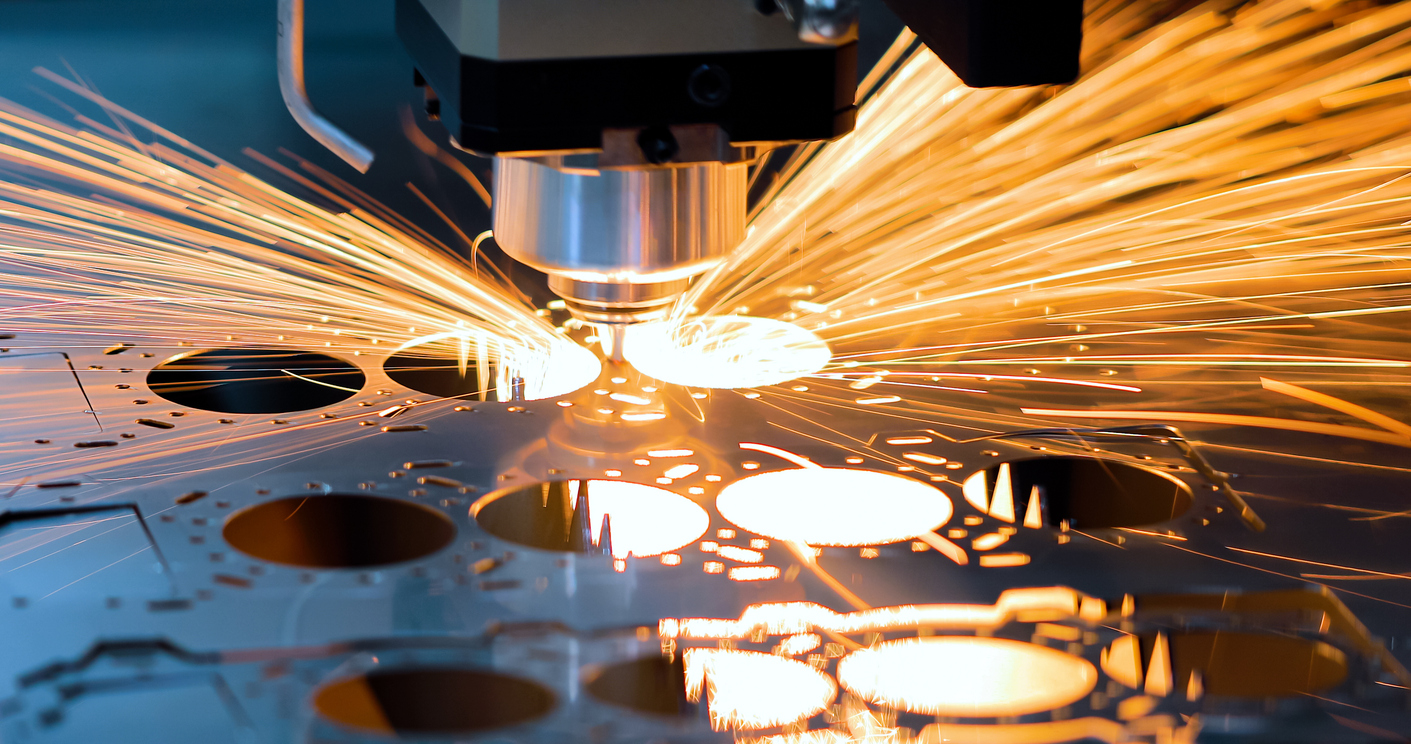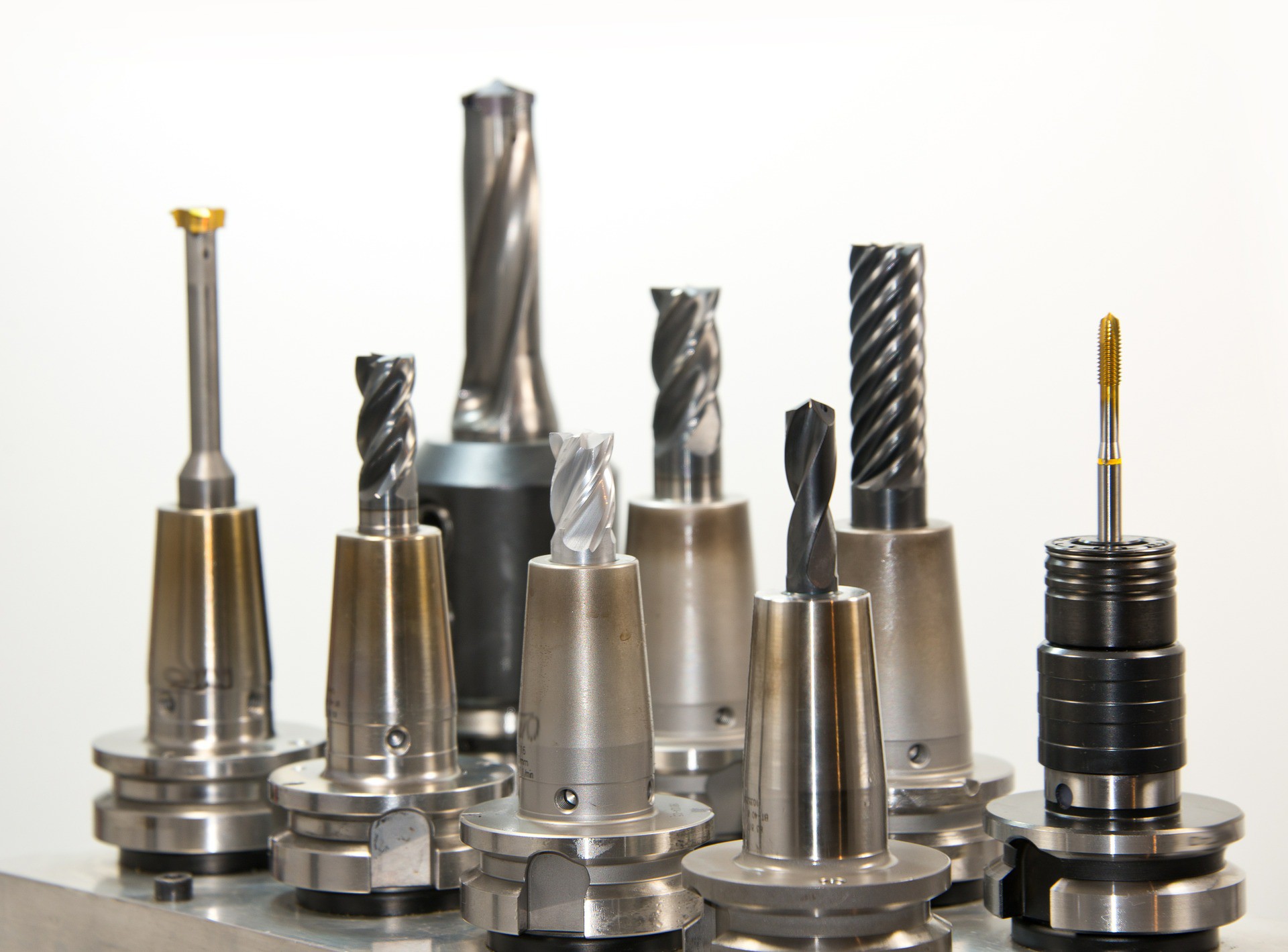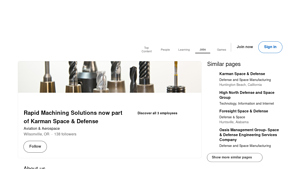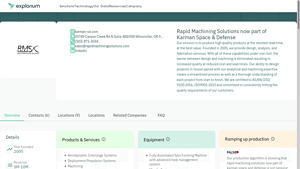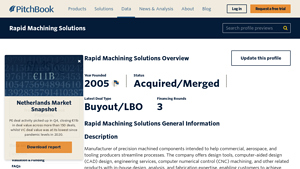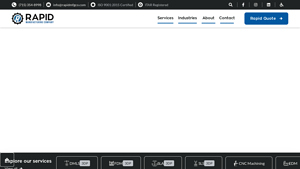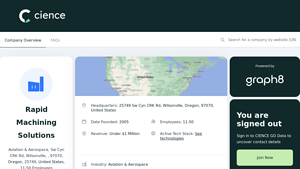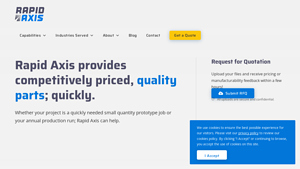Rapid Machining Solutions Guide: Type, Cost, Top List…
Introduction: Navigating the Global Market for rapid machining solutions
In today’s competitive landscape, sourcing rapid machining solutions presents a significant challenge for international B2B buyers. With the demand for precision and speed on the rise, companies must navigate a complex web of suppliers, technologies, and market conditions to secure quality components that meet stringent specifications. This guide aims to demystify the global market for rapid machining solutions by offering insights into various types of services, applications across industries, and strategies for effective supplier vetting.
From understanding the nuances of CNC machining to evaluating the cost implications of different manufacturing processes, this comprehensive resource equips decision-makers with the knowledge needed to make informed purchasing choices. We delve into the intricacies of quality certifications, such as AS/EN/JISQ 9100:2016 and ISO9001:2015, which are critical for ensuring compliance and reliability, particularly in high-stakes sectors like aerospace and defense.
Designed specifically for B2B buyers from regions such as Africa, South America, the Middle East, and Europe—including key markets like Brazil and Vietnam—this guide empowers you to streamline your sourcing process. With actionable insights and expert recommendations, you will be better positioned to identify reliable partners, optimize your supply chain, and ultimately enhance your operational efficiency in a rapidly evolving marketplace.
Understanding rapid machining solutions Types and Variations
| Type Name | Key Distinguishing Features | Primary B2B Applications | Brief Pros & Cons for Buyers |
|---|---|---|---|
| CNC Machining | Computer-controlled precision machining | Aerospace, automotive, medical devices | Pros: High accuracy, flexibility; Cons: Initial setup cost can be high. |
| Additive Manufacturing | Layer-by-layer construction using 3D printing | Prototyping, custom parts, aerospace | Pros: Design freedom, waste reduction; Cons: Slower than traditional methods for mass production. |
| Injection Molding | High-volume production through molten material | Consumer goods, automotive components | Pros: Cost-effective for large runs; Cons: High initial tooling costs. |
| Laser Cutting | High-precision cutting using laser technology | Signage, metal fabrication, aerospace | Pros: Clean cuts, minimal waste; Cons: Limited material thickness. |
| Electrical Discharge Machining (EDM) | Uses electrical discharges for intricate shapes | Aerospace, mold making, tool manufacturing | Pros: Excellent for complex geometries; Cons: Slower process, higher costs. |
What are the characteristics and suitability of CNC Machining for B2B buyers?
CNC machining stands out for its precision and repeatability, making it ideal for industries requiring high-quality components, such as aerospace and automotive. This method utilizes computer numerical control to automate the machining process, allowing for intricate designs and tight tolerances. B2B buyers should consider their volume requirements and material specifications, as CNC machining is best suited for medium to high production runs where precision is paramount.
How does Additive Manufacturing benefit B2B applications?
Additive manufacturing, or 3D printing, provides unparalleled design flexibility, enabling the production of complex geometries that traditional methods may struggle to achieve. It is particularly advantageous for prototyping and small batch production in sectors like aerospace and custom tooling. Buyers should evaluate the material options and production speed, as while it reduces waste and allows for rapid iteration, it may not be as efficient for large-scale manufacturing.
What advantages does Injection Molding offer for mass production?
Injection molding is a highly efficient process for producing large volumes of parts with consistent quality. This method is commonly used in consumer goods and automotive industries, where durability and design uniformity are essential. B2B buyers must account for the high upfront costs associated with tooling and molds, but the long-term savings in production costs make it a viable option for businesses planning significant production runs.
Why is Laser Cutting a preferred choice for precision applications?
Laser cutting is favored for its ability to produce clean, intricate cuts in various materials, including metals and plastics. This technique is widely used in signage, metal fabrication, and aerospace applications. Buyers should consider the thickness and type of materials they need to process, as laser cutting is most effective for thinner materials. While it minimizes waste and offers high-speed operation, there may be limitations regarding the thickness of materials that can be cut.
What role does Electrical Discharge Machining (EDM) play in complex manufacturing?
EDM is particularly suited for creating intricate shapes and features in hard materials, making it invaluable in industries like aerospace and mold making. This method uses electrical discharges to remove material, allowing for high precision in complex geometries. B2B buyers should weigh the benefits of precision and detail against the longer processing times and higher costs associated with EDM, particularly for larger projects.
Key Industrial Applications of rapid machining solutions
| Industry/Sector | Specific Application of rapid machining solutions | Value/Benefit for the Business | Key Sourcing Considerations for this Application |
|---|---|---|---|
| Aerospace | Precision components for aircraft systems | Improved safety and compliance with strict regulations | Certifications (e.g., AS9100), lead times, material specs |
| Defense | Machined parts for missile systems | Enhanced operational reliability and performance | Security clearances, material traceability |
| Machinery Manufacturing | Custom tooling and fixtures | Increased production efficiency and reduced downtime | Tolerance specifications, quick turnaround capabilities |
| Automotive | Engine and transmission components | Higher performance and durability of vehicle parts | Compliance with industry standards, cost-effectiveness |
| Energy | Components for renewable energy systems | Support for sustainable practices and reduced costs | Material compatibility, environmental regulations |
How is Rapid Machining Solutions Applied in the Aerospace Industry?
In the aerospace sector, rapid machining solutions are critical for producing precision components that meet stringent safety and regulatory standards. These components, which include parts for engines and structural elements, require high accuracy and quality assurance. International buyers, particularly from regions like Africa and Europe, must ensure that their suppliers hold relevant certifications such as AS9100 to guarantee compliance with aerospace industry requirements. The ability to deliver these components quickly can significantly reduce lead times, helping companies maintain schedules and avoid costly delays.
What Role Does Rapid Machining Play in Defense Applications?
Rapid machining solutions are extensively used in the defense industry to manufacture machined parts for missile systems and other military applications. These components must not only meet high-performance standards but also comply with strict security protocols. Buyers from the Middle East and South America need to consider sourcing from manufacturers that provide robust security clearances and traceability for materials. The reliability of these parts is paramount, as they directly impact mission success and operational readiness.
How Does Rapid Machining Benefit Machinery Manufacturing?
In machinery manufacturing, rapid machining solutions are employed to create custom tooling and fixtures that enhance production efficiency. These tools are often tailored to specific manufacturing processes, allowing for streamlined operations and reduced downtime. For B2B buyers in South America and Africa, understanding tolerance specifications and the supplier’s capacity for quick turnarounds is crucial. This ensures that production schedules are met without sacrificing quality, ultimately leading to cost savings.
Why is Rapid Machining Important in the Automotive Sector?
The automotive industry relies on rapid machining solutions for the production of high-performance engine and transmission components. These parts must withstand extreme conditions while ensuring optimal vehicle performance and durability. European buyers should focus on suppliers that comply with industry standards and can demonstrate cost-effectiveness in their machining processes. The ability to provide parts quickly can also play a critical role in responding to market demands and maintaining competitive advantage.
How Does Rapid Machining Support the Energy Sector?
In the energy sector, particularly in renewable energy, rapid machining solutions are utilized to manufacture components for wind turbines and solar energy systems. These components must not only be cost-effective but also meet environmental regulations. Buyers from regions like Africa and South America should prioritize suppliers that can demonstrate material compatibility and adherence to sustainability practices. This not only supports their operational goals but also aligns with global efforts toward sustainable energy practices.
3 Common User Pain Points for ‘rapid machining solutions’ & Their Solutions
Scenario 1: Struggling with Long Lead Times in Production
The Problem: One of the most pressing challenges B2B buyers face when seeking rapid machining solutions is the unanticipated long lead times. In industries like aerospace and defense, where precision and speed are critical, delays can derail production schedules and impact overall project timelines. Buyers often find themselves at the mercy of suppliers who may not clearly communicate potential delays caused by material shortages, machine downtime, or inefficient workflows. This lack of transparency can lead to frustration and financial losses as companies scramble to meet deadlines.
The Solution: To mitigate this issue, buyers should prioritize suppliers who offer comprehensive visibility into their production processes. When sourcing rapid machining solutions, ask for detailed timelines and any potential bottlenecks before finalizing contracts. Establishing a strong relationship with your supplier can also foster open communication. Implementing a vendor management system that tracks lead times, quality, and responsiveness can help buyers make informed decisions and hold suppliers accountable. Additionally, consider suppliers who utilize advanced manufacturing technologies, such as automated CNC machining and real-time tracking systems, which can significantly reduce lead times and enhance predictability.
Scenario 2: Quality Control Complications
The Problem: Quality assurance is a critical concern for B2B buyers, especially in sectors where compliance with stringent regulations is mandatory. Buyers often encounter issues where the final products do not meet the specified tolerances or quality standards, leading to costly reworks or product recalls. This is particularly challenging when working with suppliers who may not have robust quality control processes in place or lack the necessary certifications.
The Solution: To address quality control challenges, buyers should conduct thorough due diligence before selecting a rapid machining supplier. Request documentation of quality certifications, such as ISO 9001 or AS9100, to ensure that the manufacturer adheres to recognized standards. Implementing a collaborative design review process can also help catch potential issues early on. Buyers should engage in regular communication with their suppliers, including on-site visits and audits, to verify that quality assurance processes are being followed. Utilizing advanced technologies like 3D printing for prototypes can also help validate designs before full-scale production, reducing the likelihood of defects.
Scenario 3: Inadequate Customization Options
The Problem: Many B2B buyers find that the rapid machining solutions they encounter are too rigid, offering limited customization options that fail to meet their unique project specifications. This can be particularly frustrating for companies in specialized fields such as medical device manufacturing or aerospace, where specific performance characteristics are paramount. When suppliers cannot accommodate unique designs or materials, it can lead to mismatched products that do not fulfill the intended purpose.
The Solution: To overcome this hurdle, buyers should seek out suppliers that emphasize flexibility in their machining capabilities. When evaluating potential partners, inquire about their ability to handle custom designs and the range of materials they can work with. Effective communication about your specific needs and expectations is vital—providing detailed specifications and drawings can help suppliers understand your requirements better. Additionally, consider suppliers that offer integrated design and manufacturing services, as this can streamline the process and allow for more agile responses to customization requests. Collaborating with suppliers from the early design phase can also lead to innovative solutions tailored to your exact needs, ultimately enhancing product performance and satisfaction.
Strategic Material Selection Guide for rapid machining solutions
When selecting materials for rapid machining solutions, understanding the properties, advantages, and limitations of various materials is crucial for B2B buyers. This section analyzes four common materials used in rapid machining: Aluminum, Stainless Steel, Titanium, and Polycarbonate. Each material has unique characteristics that can significantly impact product performance and suitability for specific applications.
What Are the Key Properties of Aluminum in Rapid Machining Solutions?
Aluminum is widely recognized for its lightweight and excellent corrosion resistance. It boasts a high strength-to-weight ratio and good thermal conductivity, making it suitable for applications requiring weight savings without compromising structural integrity. Aluminum is also easy to machine, which contributes to reduced lead times and lower manufacturing costs.
Pros and Cons of Using Aluminum
The primary advantage of aluminum is its lightweight nature, which is beneficial in industries like aerospace and automotive. However, while it is durable, it may not withstand extreme temperatures or high-pressure environments as effectively as other metals. Additionally, aluminum can be more expensive than some alternatives, depending on the alloy used.
Impact on Application and Considerations for International Buyers
Aluminum’s compatibility with various media makes it ideal for applications in the automotive and aerospace sectors. Buyers from regions like Africa and South America should consider compliance with international standards such as ASTM and ISO to ensure quality and reliability.
How Does Stainless Steel Compare for Rapid Machining Solutions?
Stainless steel is renowned for its exceptional strength and resistance to corrosion and oxidation. It can withstand high temperatures and pressures, making it suitable for demanding applications in industries such as oil and gas, pharmaceuticals, and food processing.
Pros and Cons of Using Stainless Steel
The key advantage of stainless steel is its durability and longevity, which can reduce long-term costs associated with maintenance and replacement. However, it is more challenging to machine than aluminum, which can lead to increased manufacturing complexity and costs. Additionally, the weight of stainless steel can be a disadvantage in applications where weight is a critical factor.
Impact on Application and Considerations for International Buyers
Stainless steel’s compatibility with harsh environments makes it ideal for applications in the Middle East’s oil and gas sector. Buyers should ensure that the material complies with relevant standards such as DIN and JIS, particularly when exporting to or sourcing from Europe.
What Are the Benefits of Using Titanium in Rapid Machining Solutions?
Titanium is celebrated for its high strength, low weight, and excellent corrosion resistance. It is particularly valuable in applications where high performance and durability are essential, such as aerospace and medical devices.
Pros and Cons of Using Titanium
The primary advantage of titanium is its exceptional strength-to-weight ratio, making it ideal for high-performance applications. However, titanium is more expensive and challenging to machine compared to aluminum and stainless steel, which can lead to longer lead times and higher production costs.
Impact on Application and Considerations for International Buyers
Titanium’s compatibility with various environments, including saline conditions, makes it suitable for marine and aerospace applications. Buyers from Europe and the Middle East should be aware of the stringent quality standards and certifications required for titanium components.
How Does Polycarbonate Fit into Rapid Machining Solutions?
Polycarbonate is a robust thermoplastic known for its impact resistance and optical clarity. It is often used in applications where transparency and durability are essential, such as in safety equipment and electronic housings.
Pros and Cons of Using Polycarbonate
The key advantage of polycarbonate is its lightweight nature and high impact resistance, making it suitable for protective applications. However, it has lower thermal resistance compared to metals and can be prone to scratching, which may limit its use in certain environments.
Impact on Application and Considerations for International Buyers
Polycarbonate’s versatility makes it suitable for various applications across different industries. Buyers should consider local regulations regarding plastic materials and ensure compliance with relevant standards.
Summary of Material Selection for Rapid Machining Solutions
| Material | Typical Use Case for rapid machining solutions | Key Advantage | Key Disadvantage/Limitation | Relative Cost (Low/Med/High) |
|---|---|---|---|---|
| Aluminum | Aerospace components, automotive parts | Lightweight and corrosion-resistant | Limited high-temperature performance | Medium |
| Stainless Steel | Oil and gas equipment, food processing tools | High strength and corrosion resistance | Difficult to machine, heavy | High |
| Titanium | Aerospace, medical implants | Exceptional strength-to-weight ratio | Expensive and challenging to machine | High |
| Polycarbonate | Safety equipment, electronic housings | Impact resistance and lightweight | Lower thermal resistance, scratches | Medium |
This guide provides B2B buyers with a comprehensive understanding of material selection for rapid machining solutions, enabling informed decisions that align with industry standards and application requirements.
In-depth Look: Manufacturing Processes and Quality Assurance for rapid machining solutions
What Are the Key Stages in Manufacturing Rapid Machining Solutions?
Manufacturing rapid machining solutions involves several crucial stages designed to optimize efficiency and quality. The main stages include material preparation, forming, assembly, and finishing. Each stage employs specific techniques and tools tailored to the project requirements, ultimately delivering precision components that meet stringent industry standards.
How Is Material Prepared for Rapid Machining?
The manufacturing process begins with meticulous material preparation. This stage involves selecting appropriate raw materials based on project specifications, which may include metals like aluminum, titanium, or composites. Material inspection is critical here to ensure that the raw stock is free from defects and meets the specified chemical and mechanical properties.
Once the material is selected, it undergoes processes such as cutting, shearing, or machining to achieve the desired dimensions. Advanced techniques like laser cutting or waterjet cutting may be employed for high precision and reduced waste. These methods also facilitate rapid turnaround times, aligning with the core objective of rapid machining solutions.
What Techniques Are Used in the Forming Stage?
The forming stage is where the prepared material is shaped into the desired component. Techniques such as CNC (Computer Numerical Control) machining are prevalent in this phase. CNC machining allows for high precision and repeatability, essential for producing complex geometries that meet exact specifications.
In addition to CNC machining, additive manufacturing techniques, like 3D printing, are increasingly being integrated into the forming stage. This approach enables the production of intricate designs that would be challenging or impossible to achieve with traditional methods. The combination of subtractive and additive techniques provides manufacturers with flexibility and innovation in their machining processes.
How Is Assembly Conducted in Rapid Machining Solutions?
Following the forming stage, components may require assembly. This process can involve welding, fastening, or bonding different parts together to create a final product. For rapid machining solutions, assembly is often streamlined to minimize delays and maximize efficiency.
Employing techniques such as modular assembly can significantly reduce assembly time. Each module can be manufactured simultaneously, allowing for parallel processing. This method is particularly beneficial for large projects with multiple components, ensuring that timelines are adhered to without compromising quality.
What Finishing Processes Are Commonly Used?
Finishing is the final stage in the manufacturing process, enhancing the component’s surface quality and functionality. Common finishing techniques include machining, grinding, polishing, and coating. These processes not only improve aesthetics but also increase durability and corrosion resistance, which are critical in industries like aerospace and defense.
Surface treatment methods, such as anodizing or electroplating, may also be applied to provide additional protective layers. The choice of finishing technique often depends on the end-use of the component and industry-specific requirements.
What Quality Assurance Measures Are Essential in Rapid Machining?
Quality assurance (QA) is integral to the manufacturing process of rapid machining solutions. It ensures that products meet international standards and customer expectations. Implementing a robust QA framework involves adherence to various international and industry-specific standards, as well as establishing effective quality control (QC) checkpoints.
Which International Standards Should B2B Buyers Consider?
For B2B buyers, understanding the relevant international standards is crucial for supplier evaluation. Standards such as ISO 9001:2015 provide a framework for quality management systems, focusing on continuous improvement and customer satisfaction. In addition, industry-specific certifications like AS/EN/JISQ 9100:2016 are particularly relevant for aerospace and defense sectors, ensuring that manufacturers comply with stringent quality requirements.
Buyers should also look for compliance with CE marking for products sold within the European Economic Area, which indicates conformity with health, safety, and environmental protection standards.
What Are the Key QC Checkpoints in the Manufacturing Process?
Quality control checkpoints are essential for monitoring and verifying product quality throughout the manufacturing process. Common QC checkpoints include:
-
Incoming Quality Control (IQC): This initial stage involves inspecting raw materials and components as they arrive at the facility. Ensuring materials meet specifications before production begins is vital to maintaining overall quality.
-
In-Process Quality Control (IPQC): During manufacturing, regular inspections and measurements are conducted to verify that processes remain within specified limits. This proactive approach helps identify issues before they escalate.
-
Final Quality Control (FQC): After production, FQC checks the finished products against specifications to confirm they meet quality standards. This step may involve functional testing, dimensional checks, and visual inspections.
How Can B2B Buyers Verify Supplier Quality Control?
To ensure that a supplier’s quality control measures align with their requirements, B2B buyers should consider several verification strategies:
-
Supplier Audits: Conducting regular audits of suppliers allows buyers to assess their quality management systems, processes, and compliance with relevant standards. These audits can be performed by the buyer’s quality team or through third-party agencies.
-
Requesting Quality Reports: Buyers should ask for detailed QC reports, including inspection results and any corrective actions taken. These documents provide insight into the supplier’s commitment to quality and areas of improvement.
-
Third-Party Inspections: Engaging third-party inspection services can offer an unbiased assessment of a supplier’s manufacturing processes and products. These inspections can help identify potential risks and provide additional assurance of quality.
What Are the Quality Control Nuances for International B2B Buyers?
For B2B buyers operating in regions like Africa, South America, the Middle East, and Europe, understanding the nuances of quality control is essential. Regional regulations may vary, impacting the certification requirements and acceptance criteria for products.
Buyers should be aware of the specific compliance and certification processes applicable in their regions. Engaging with local regulatory bodies and industry associations can provide valuable insights into regional standards and best practices.
Furthermore, cultural considerations may influence supplier relationships and quality expectations. Building strong partnerships with suppliers who understand the nuances of local markets can enhance communication and foster better quality outcomes.
Conclusion
The manufacturing processes and quality assurance measures for rapid machining solutions are critical for ensuring high-quality products that meet the demands of diverse industries. By understanding the key stages in manufacturing, the essential quality control measures, and the nuances of international standards, B2B buyers can make informed decisions when selecting suppliers. This comprehensive approach not only mitigates risks but also enhances the overall quality of the products sourced, ultimately contributing to the success of their business operations.
Practical Sourcing Guide: A Step-by-Step Checklist for ‘rapid machining solutions’
In the fast-paced world of manufacturing, sourcing rapid machining solutions requires a strategic approach to ensure quality and efficiency. This guide provides a practical checklist designed for B2B buyers seeking reliable suppliers for precision machining services. By following these steps, you can streamline your procurement process and make informed decisions that align with your operational needs.
Step 1: Define Your Technical Specifications
Before initiating the sourcing process, clearly outline your technical requirements. This includes dimensions, tolerances, materials, and any specific finishing processes needed. Having a detailed specification helps potential suppliers assess their capability to meet your needs and ensures that you receive accurate quotes.
- Considerations: Identify critical tolerances and performance requirements to avoid issues during production.
- Documentation: Prepare CAD files or drawings to facilitate clear communication with suppliers.
Step 2: Research Potential Suppliers
Conduct thorough research to identify suppliers that specialize in rapid machining solutions. Look for companies with a proven track record in your industry, whether it’s aerospace, defense, or machinery manufacturing.
- Sources: Utilize industry directories, trade shows, and online platforms like LinkedIn to gather information.
- Reputation: Check for customer reviews, testimonials, and case studies to gauge supplier reliability.
Step 3: Verify Supplier Certifications
Quality assurance is paramount in rapid machining. Ensure that potential suppliers hold relevant certifications such as AS9100 or ISO 9001, which reflect their commitment to quality management systems.
- Importance: Certifications indicate adherence to industry standards and can mitigate risks associated with product quality.
- Documentation Request: Ask for copies of certification documents to validate compliance.
Step 4: Evaluate Manufacturing Capabilities
Assess the manufacturing capabilities of each potential supplier. This includes their machinery, technology, and production processes. A supplier with advanced CNC machines and automation can often deliver higher precision and faster turnaround times.
- Visit Facilities: If possible, arrange for site visits to inspect machinery and understand production workflows.
- Technology Integration: Inquire about their use of software tools for design and quality control.
Step 5: Request Detailed Quotes
Once you have shortlisted suppliers, request detailed quotes that outline pricing, lead times, and terms of service. Ensure that quotes are itemized so you can compare costs transparently.
- Cost Breakdown: Look for clarity on material costs, labor, and any additional fees.
- Lead Times: Evaluate how the lead times align with your project timelines.
Step 6: Assess Communication and Support
Effective communication is crucial for successful collaboration. Evaluate how responsive and supportive each supplier is during the inquiry phase.
- Communication Channels: Determine if they offer multiple communication channels and how quickly they respond to inquiries.
- Post-Sale Support: Inquire about their support policies for addressing issues that may arise after delivery.
Step 7: Conduct a Risk Assessment
Finally, perform a risk assessment of your chosen suppliers. Consider factors such as financial stability, geopolitical risks, and supply chain reliability.
- Financial Health: Request financial statements or credit checks to ensure they can sustain operations.
- Contingency Plans: Discuss their strategies for managing supply chain disruptions to ensure continuity.
By following these steps, B2B buyers can confidently procure rapid machining solutions that meet their specifications, ensuring quality and efficiency in their manufacturing processes.
Comprehensive Cost and Pricing Analysis for rapid machining solutions Sourcing
What Are the Key Cost Components in Rapid Machining Solutions?
When sourcing rapid machining solutions, understanding the cost structure is crucial for international B2B buyers. The primary cost components include:
-
Materials: The choice of materials significantly affects pricing. Common materials like aluminum or plastics are typically less expensive, while high-performance alloys or specialized composites can drive costs up.
-
Labor: Skilled labor is essential in precision machining. The labor cost varies by region, with developed markets generally experiencing higher wage rates. Investing in skilled labor can lead to improved quality and efficiency.
-
Manufacturing Overhead: This includes costs associated with facilities, utilities, and equipment maintenance. Efficient manufacturing processes can minimize these overheads, contributing to lower overall costs.
-
Tooling: The cost of tooling can vary based on the complexity of the components being produced. Custom tooling may be required for specialized parts, which can increase initial costs but may lead to savings in long-term production.
-
Quality Control (QC): Implementing rigorous QC measures ensures that products meet specifications, reducing the risk of defects. However, these measures can add to the overall cost, particularly if certifications (like ISO9001) are required.
-
Logistics: Shipping and handling costs must be considered, especially for international orders. These costs can fluctuate based on the shipping method, distance, and any tariffs or duties applicable.
-
Margin: Suppliers typically build a profit margin into their pricing. Understanding the market dynamics can help buyers negotiate better terms.
How Do Price Influencers Impact Rapid Machining Solutions?
Several factors influence pricing in rapid machining solutions:
-
Volume and Minimum Order Quantities (MOQ): Larger order volumes often lead to lower per-unit costs due to economies of scale. Suppliers may offer discounts based on volume commitments.
-
Specifications and Customization: Custom parts tailored to specific requirements can increase costs. Buyers should clearly define specifications to avoid unnecessary expenses.
-
Materials and Quality Certifications: The choice of material and required certifications (like AS/EN/JISQ 9100:2016) can affect pricing. Higher quality or specialized materials often come with a premium.
-
Supplier Factors: The reputation, location, and capabilities of suppliers play a significant role in pricing. Established suppliers with robust quality systems may command higher prices but often provide better reliability.
-
Incoterms: Understanding the terms of trade (Incoterms) is crucial for budgeting. Terms such as FOB (Free on Board) or CIF (Cost, Insurance, and Freight) can affect the total landed cost of goods.
What Negotiation Tips Can Help Buyers Optimize Costs?
International B2B buyers can employ several strategies to enhance cost-efficiency:
-
Conduct Market Research: Understanding the prevailing market prices and supplier capabilities can provide leverage during negotiations.
-
Leverage Long-Term Relationships: Building strong relationships with suppliers can lead to better pricing and terms. Suppliers may offer discounts to loyal customers.
-
Focus on Total Cost of Ownership (TCO): Consider not just the initial purchase price but also the costs associated with quality, maintenance, and logistics. A lower upfront cost may lead to higher TCO if quality issues arise.
-
Be Aware of Pricing Nuances: Different regions may have varying pricing structures due to labor, material availability, and production capabilities. Buyers should factor these into their sourcing decisions.
-
Negotiate Payment Terms: Flexible payment terms can improve cash flow and may be a point of negotiation that could lead to better pricing.
What Should International Buyers Know About Pricing?
For buyers from regions such as Africa, South America, the Middle East, and Europe, understanding local market dynamics and global supply chain factors is essential. Currency fluctuations, trade policies, and regional demand can significantly affect pricing. Always request indicative prices while considering the potential for adjustments based on changing market conditions.
In summary, comprehensively analyzing the cost structure and pricing influencers, along with employing effective negotiation strategies, can empower international B2B buyers to make informed decisions when sourcing rapid machining solutions.
Alternatives Analysis: Comparing rapid machining solutions With Other Solutions
Understanding Alternatives to Rapid Machining Solutions
In the rapidly evolving landscape of manufacturing and production, businesses often seek out various machining solutions to meet their specific operational needs. Rapid machining solutions, known for their quick turnaround and precision, are just one option among several. This section explores alternative methods, highlighting their respective advantages and challenges, allowing B2B buyers to make informed decisions tailored to their unique requirements.
Comparison of Rapid Machining Solutions and Alternatives
| Comparison Aspect | Rapid Machining Solutions | CNC Machining | 3D Printing |
|---|---|---|---|
| Performance | High precision; quick production | High precision; versatile materials | Variable precision; ideal for complex geometries |
| Cost | Moderate to high; economies of scale | Moderate; setup costs can be high | Lower for prototyping; can become expensive for large runs |
| Ease of Implementation | Streamlined; in-house design | Requires skilled operators; setup time can be lengthy | User-friendly for designs; minimal setup required |
| Maintenance | Regular upkeep needed for machines | Routine maintenance necessary | Minimal maintenance; mostly software updates |
| Best Use Case | Aerospace, defense, tooling | General manufacturing, automotive | Prototyping, custom parts, low-volume production |
Detailed Breakdown of Alternatives
CNC Machining
CNC (Computer Numerical Control) machining is a widely adopted method that offers high precision and versatility across various materials, including metals and plastics. The primary advantage of CNC machining lies in its ability to produce complex geometries with high repeatability. However, it can entail significant setup costs and requires skilled operators to manage the machinery effectively. This method is best suited for industries that require consistent quality and have high production volumes, such as automotive and general manufacturing.
3D Printing
3D printing, or additive manufacturing, has gained traction as an innovative alternative that allows for the creation of complex shapes and designs with minimal material waste. It is particularly beneficial for rapid prototyping and producing custom parts in low volumes. The ease of use and relatively low initial setup costs make 3D printing an attractive option for startups and companies looking to test designs quickly. However, the cost can escalate for larger production runs, and the precision may not match that of traditional machining methods, which can be a drawback for industries requiring stringent tolerances.
Conclusion: Choosing the Right Solution for Your Business
When selecting a machining solution, B2B buyers must consider their specific operational needs, including production volume, material requirements, and precision standards. Rapid machining solutions offer a robust option for industries like aerospace and defense, emphasizing speed and quality. In contrast, CNC machining provides versatility and consistency for larger manufacturing operations, while 3D printing excels in rapid prototyping and customized projects. By weighing the pros and cons of each alternative against their operational goals, buyers can make a strategic choice that aligns with their business objectives and enhances their production capabilities.
Essential Technical Properties and Trade Terminology for rapid machining solutions
What are the Essential Technical Properties of Rapid Machining Solutions?
When considering rapid machining solutions, understanding key technical specifications is crucial for making informed purchasing decisions. Here are some of the most important properties to keep in mind:
1. Material Grade
Material grade refers to the specific classification of materials used in machining, such as metals, plastics, or composites. The grade affects the strength, durability, and suitability of the component for its intended application. For instance, aerospace components often require high-strength alloys to withstand extreme conditions, whereas medical devices may need biocompatible materials. Selecting the right material grade ensures that the final product meets regulatory and performance standards.
2. Tolerance
Tolerance defines the permissible limit or limits of variation in a physical dimension. It is critical in machining because it dictates how closely a manufactured part must conform to specified dimensions. Tight tolerances (e.g., ±0.001 inches) are essential in applications like aerospace and automotive, where precision is paramount. Understanding tolerance requirements helps buyers communicate their needs effectively and ensures that suppliers can meet those specifications.
3. Surface Finish
Surface finish is the measure of the texture of a manufactured surface and can significantly influence performance characteristics, such as friction, wear, and corrosion resistance. A smooth surface finish may be required for components that experience high friction, while rough finishes might be beneficial for better adhesion in certain applications. Buyers should specify their surface finish requirements to avoid post-production modifications.
4. Machining Speed
Machining speed refers to the rate at which material is removed during the machining process. It directly impacts production efficiency and costs. Faster machining speeds can reduce lead times, making it crucial for buyers to understand the capabilities of their suppliers. Balancing speed with quality is vital; high speeds without proper control can lead to defects and increased waste.
5. Dimensional Stability
Dimensional stability indicates a material’s ability to maintain its shape and size under varying environmental conditions, such as temperature and humidity. This property is particularly important for industries that require consistent performance over time, such as aerospace or automotive. Buyers should inquire about the dimensional stability of materials used in production to ensure long-term reliability.
What are Common Trade Terms in Rapid Machining Solutions?
Familiarity with industry jargon is essential for effective communication between buyers and suppliers. Here are some common terms that every B2B buyer should know:
1. OEM (Original Equipment Manufacturer)
An OEM is a company that produces parts or equipment that may be marketed by another manufacturer. Understanding the role of OEMs is vital for buyers who need to source specific components that integrate into larger systems. OEMs often provide higher quality and reliability compared to generic alternatives.
2. MOQ (Minimum Order Quantity)
MOQ refers to the smallest number of units a supplier is willing to sell. This term is crucial for buyers, as it impacts inventory management and cash flow. Understanding MOQs can help businesses plan their purchases more effectively and negotiate better terms with suppliers.
3. RFQ (Request for Quotation)
An RFQ is a document issued by a buyer to solicit price quotes from suppliers for specific products or services. It outlines the required specifications, quantities, and timelines. Utilizing RFQs enables buyers to compare pricing and terms from multiple suppliers, facilitating informed decision-making.
4. Incoterms
Incoterms, or International Commercial Terms, are a series of predefined commercial terms published by the International Chamber of Commerce (ICC) that clarify the responsibilities of buyers and sellers. They define who is responsible for shipping costs, insurance, and tariffs during the transportation of goods. Understanding Incoterms helps buyers manage logistics and reduce potential disputes.
5. CNC (Computer Numerical Control)
CNC refers to the automated control of machining tools via a computer. It allows for precise and repeatable machining processes, making it a cornerstone of modern manufacturing. Buyers should look for suppliers that utilize CNC technology for improved accuracy and efficiency in their production processes.
By grasping these essential technical properties and trade terms, B2B buyers can enhance their purchasing strategies, ensuring they choose the right rapid machining solutions for their needs.
Navigating Market Dynamics and Sourcing Trends in the rapid machining solutions Sector
What Are the Key Market Drivers and Trends in Rapid Machining Solutions?
The rapid machining solutions sector is experiencing significant transformation driven by technological advancements and shifting market demands. One of the primary global drivers is the increasing need for shorter lead times and enhanced quality in manufacturing processes. Businesses across various industries, including aerospace, automotive, and medical, are emphasizing precision and efficiency, which drives the adoption of rapid machining solutions. Furthermore, the integration of Industry 4.0 technologies, such as IoT and AI, is reshaping sourcing strategies, allowing for smarter inventory management and real-time data analytics.
Emerging trends highlight the growing importance of on-demand manufacturing and customization. International B2B buyers, particularly from regions like Africa, South America, the Middle East, and Europe, are increasingly seeking suppliers who can offer flexible and scalable solutions tailored to their specific needs. This trend is particularly evident in markets like Brazil and Vietnam, where local manufacturers are prioritizing agility and responsiveness to compete in a globalized environment. Additionally, companies are leveraging digital platforms for sourcing, enhancing visibility and collaboration across supply chains.
How Does Sustainability and Ethical Sourcing Impact Rapid Machining Solutions?
As environmental concerns gain traction globally, sustainability has become a crucial factor in the procurement of rapid machining solutions. B2B buyers are now more than ever prioritizing suppliers who demonstrate a commitment to reducing their environmental impact. This includes the adoption of sustainable practices in sourcing materials, such as utilizing recyclable or biodegradable components, and implementing energy-efficient manufacturing processes.
Ethical sourcing is also becoming increasingly relevant, with buyers looking for suppliers that maintain transparency in their supply chains. Certifications such as ISO 14001 (Environmental Management) and adherence to green manufacturing standards are essential for demonstrating a commitment to sustainability. Moreover, implementing robust supply chain audits can help ensure compliance with ethical practices, minimizing risks associated with labor exploitation and environmental degradation. By prioritizing sustainable and ethical sourcing, companies not only enhance their brand reputation but also contribute to broader environmental goals, aligning with the values of a growing consumer base that prioritizes corporate responsibility.
What Is the Historical Context of Rapid Machining Solutions?
The rapid machining solutions sector has evolved significantly since its inception in the early 2000s. Initially focused on serving niche markets, the sector has expanded to meet the demands of a broader range of industries, propelled by advancements in technology and the increasing complexity of manufacturing processes. The integration of CAD and CNC technologies revolutionized production capabilities, enabling precision machining and rapid prototyping.
In recent years, mergers and acquisitions, such as the acquisition of Rapid Machining Solutions by Karman Space & Defense, have further shaped the landscape, allowing companies to consolidate resources and expertise. This evolution reflects a strategic shift towards offering comprehensive solutions that encompass design, analysis, and fabrication all under one roof. As the sector continues to mature, it remains poised for further growth, driven by innovation and an ever-increasing emphasis on quality and efficiency.
Frequently Asked Questions (FAQs) for B2B Buyers of rapid machining solutions
1. How can I ensure the quality of rapid machining solutions?
To ensure the quality of rapid machining solutions, it is crucial to partner with suppliers who possess relevant certifications such as AS/EN/JISQ 9100:2016 and ISO 9001:2015. These certifications indicate adherence to international quality management standards. Additionally, consider suppliers that provide detailed quality assurance processes, including material traceability, in-process inspections, and final product evaluations. Requesting samples or prototypes can also help evaluate a supplier’s quality before placing larger orders.
2. What are the typical lead times for rapid machining projects?
Lead times for rapid machining projects can vary based on the complexity of the design, material selection, and current workload of the supplier. Generally, rapid machining aims to shorten lead times, often delivering components within a few days to weeks. When sourcing internationally, consider potential delays due to customs and shipping. It’s advisable to communicate your timeline requirements clearly with suppliers and request a detailed project timeline to avoid surprises.
3. What customization options are available in rapid machining solutions?
Most rapid machining suppliers offer a variety of customization options to meet specific project needs. This may include alterations in design, material selection, surface finishes, and dimensional specifications. When discussing your project, be clear about your requirements and ask the supplier about their capabilities in customization. Some suppliers might also provide design support or CAD services to help refine your project before machining begins.
4. What are the minimum order quantities (MOQs) for rapid machining services?
Minimum order quantities (MOQs) for rapid machining services can differ significantly among suppliers. Some may have no minimums for prototyping or small batch runs, while others might require larger quantities for cost-effectiveness. When evaluating suppliers, inquire about their MOQs and whether they can accommodate smaller orders, particularly if you are testing a new product or entering a new market.
5. How should I vet a supplier for international rapid machining solutions?
Vetting a supplier for international rapid machining solutions involves assessing their experience, reputation, and capabilities. Start by reviewing their certifications and past projects. Look for customer testimonials and case studies that demonstrate successful partnerships. Additionally, consider visiting their facility or scheduling a virtual tour to evaluate their equipment and quality control processes. Engaging in direct communication with their team can also provide insights into their responsiveness and customer service.
6. What payment terms should I expect when sourcing rapid machining solutions internationally?
Payment terms in international B2B transactions for rapid machining solutions can vary widely. Common terms include upfront deposits, progress payments, and net payment upon delivery. It is essential to discuss payment options early in negotiations and ensure clarity on currency, exchange rates, and any potential fees. Using secure payment methods, such as letters of credit, can provide additional protection for both parties in the transaction.
7. How do logistics affect the sourcing of rapid machining solutions?
Logistics play a critical role in the sourcing of rapid machining solutions, particularly when dealing with international suppliers. Factors such as shipping methods, customs regulations, and lead times can significantly impact delivery schedules and costs. It is vital to collaborate with suppliers who have experience in international shipping and can provide insights into potential delays and documentation requirements. Consider using a logistics partner to streamline the process and ensure timely delivery.
8. What industries typically utilize rapid machining solutions?
Rapid machining solutions are commonly utilized across various industries, including aerospace, defense, automotive, and medical devices. These sectors benefit from the ability to produce high-quality components quickly and efficiently, which is crucial for maintaining competitive advantage. When sourcing rapid machining services, ensure that the supplier has experience and expertise in your specific industry to meet regulatory standards and performance requirements effectively.
Important Disclaimer & Terms of Use
⚠️ Important Disclaimer
The information provided in this guide, including content regarding manufacturers, technical specifications, and market analysis, is for informational and educational purposes only. It does not constitute professional procurement advice, financial advice, or legal advice.
While we have made every effort to ensure the accuracy and timeliness of the information, we are not responsible for any errors, omissions, or outdated information. Market conditions, company details, and technical standards are subject to change.
B2B buyers must conduct their own independent and thorough due diligence before making any purchasing decisions. This includes contacting suppliers directly, verifying certifications, requesting samples, and seeking professional consultation. The risk of relying on any information in this guide is borne solely by the reader.
Top 6 Rapid Machining Solutions Manufacturers & Suppliers List
1. LinkedIn – Quality Products
Domain: linkedin.com
Registered: 2002 (23 years)
Introduction: This company, LinkedIn – Quality Products, is a notable entity in the market. For specific product details, it is recommended to visit their website directly.
2. Explorium – Rapid Machining Solutions
Domain: explorium.ai
Registered: 2018 (7 years)
Introduction: Rapid Machining Solutions, now part of Karman Space & Defense, offers design, analysis, and fabrication services. Key products include Aerodynamic Interstage Systems, Deployment Propulsion Systems, and Machining services. They utilize equipment such as a Fully Automated Spin Forming Machine with advanced heat management system, Missile Systems, and Rocket Motor Assemblies. The company is certified…
3. PitchBook – Precision Machined Components
Domain: pitchbook.com
Registered: 2004 (21 years)
Introduction: This company, PitchBook – Precision Machined Components, is a notable entity in the market. For specific product details, it is recommended to visit their website directly.
4. Rapid Manufacturing Company – On-Demand Manufacturing Services
Domain: rapidmfgco.com
Registered: 2023 (2 years)
Introduction: Rapid Manufacturing Company offers a range of on-demand manufacturing services including: 1. DMLS (Direct Metal Laser Sintering) 2. FDM (Fused Deposition Modeling) 3. SLA (Stereolithography) 4. SLS (Selective Laser Sintering) 5. CNC Machining 6. EDM (Sinker and Wire) 7. Injection Molding 8. RTV Molding (Cast Urethane) 9. Sheet Metal 10. Weldments. The company serves various industries such as Aero…
5. Science – Rapid Machining Solutions
Domain: cience.com
Registered: 2005 (20 years)
Introduction: Rapid Machining Solutions provides design, analysis, and fabrication services in the Aviation & Aerospace industry. Their mission is to produce high-quality products at the shortest lead time and best value. They are certified to AS/EN/JISQ 9100:2016 and ISO9001:2015, ensuring they meet quality requirements consistently. Founded in 2005, the company operates with 11-50 employees and generates reve…
6. Rapid Axis – Comprehensive CNC and Fabrication Solutions
Domain: rapidaxis.com
Registered: 2018 (7 years)
Introduction: Rapid Axis offers a range of manufacturing capabilities including CNC Machining (3, 4, and 5 Axis), CNC Milling, CNC Turning, 2nd Op Machining, COTS, Manual Machining, Sheet Metal Fabrication, Sheet Metal Prototyping, Laser Cutting, Waterjet Cutting, and various 3D Printing technologies (FDM, MJF, SLS, SLA, Polyjet). They also provide Tooling and Molding services, Urethane Casting, Production & Pr…
Strategic Sourcing Conclusion and Outlook for rapid machining solutions
What Are the Key Takeaways for B2B Buyers in Rapid Machining Solutions?
In today’s competitive landscape, the integration of design and machining capabilities is crucial for ensuring quality and efficiency. Rapid Machining Solutions exemplifies this by providing in-house design, analysis, and fabrication services, which significantly shorten lead times while maintaining high standards of quality. For international B2B buyers, particularly those from Africa, South America, the Middle East, and Europe, leveraging strategic sourcing in rapid machining can lead to substantial cost savings and enhanced product quality.
How Can Strategic Sourcing Enhance Your Procurement Process?
Strategic sourcing allows companies to identify and collaborate with suppliers who offer the best value, aligning with specific project needs and timelines. As the demand for precision components in industries like aerospace and defense continues to rise, engaging with trusted suppliers who can deliver rapid machining solutions will become increasingly vital.
What’s Next for International B2B Buyers?
As we look to the future, the emphasis on rapid, cost-effective machining will only intensify. B2B buyers should proactively seek partnerships with manufacturers that prioritize innovation and efficiency. By doing so, they can not only meet market demands but also position themselves as leaders in their respective sectors. Explore the possibilities of rapid machining solutions today and elevate your strategic sourcing efforts for sustained growth and success.
